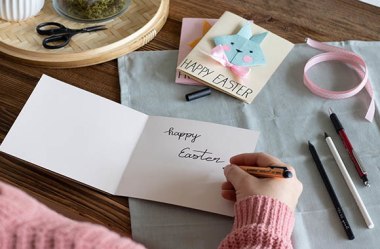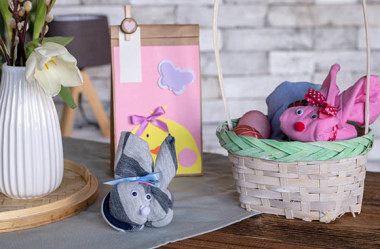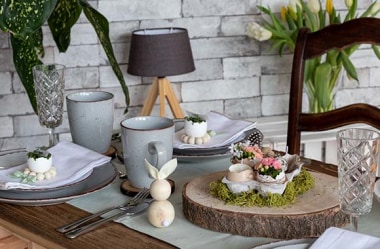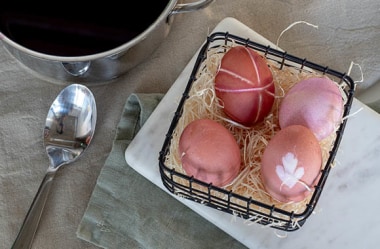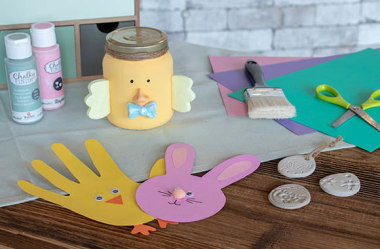Easter story – Where do our Easter traditions come from?
Easter is a colourful festival celebrated almost everywhere in the world. A cute bunny hides some eggs and then the fun of an Easter egg hunt starts – these are just two parts of our best-known Easter traditions. At first glance, it’s not always obvious what eggs and a bunny have to do with the classic Easter story. In this article, we explain why we celebrate Easter and where the most important customs come from.
The Easter Story – Why do we celebrate Easter?
What actually is Easter? The origins of Easter are varied, but the spring festival has one thing in common around the world: Easter welcomes the dawn on spring and bids farewell to winter. It is a celebration of life, new beginnings, and fertility. Below we list the different Easter stories that explain the different origins of Easter:
- Even ancient peoples celebrated annual festivals to mark the beginning of spring. With dances, songs and offerings to the gods, they welcomed spring and asked for a rich harvest.
- Another origin of Easter begins in the Jewish Passover. This festival celebrates the exodus of the Jews from Egypt and the end of slavery, as it was handed down in the Old Testament.
- The most significant story for the Easter customs of Western cultures comes from Christianity, where the resurrection of Jesus Christ is celebrated. The holidays and customs stem from the Bible and are still influential in how we celebrate Easter today.
The story behind Easter holidays
- Maundy Thursday: Traditionally, Easter begins on Maundy Thursday, the day of the Last Supper. That evening, Jesus Christ was betrayed by his disciple Judas and arrested by the Romans. Maundy Thursday celebrates the Last Supper while at the same time mourns the arrest of Jesus Christ.
- Good Friday: The Christian Bible describes Jesus Christ’s crucifixion and death on Good Friday. Christians mourn for Jesus Christ on the Friday before Easter.
- Holy Saturday: Similar to Good Friday, this is a silent day of remembrance, sanctifying the burial of Jesus Christ. As the Bible states that Jesus Christ rose from the dead in the evening, the Holy Week comes to an end and the joyful Easter season begins.
- Easter Sunday: Easter Sunday is the most significant Easter holiday as it honours the resurrection of Jesus Christ. It celebrates a new beginning and the new hope that comes with it.
- Easter Monday: According to the Bible, Easter Monday commemorates the walk to Emmaus. Two disciples were making their way back to Emmaus when an unknown man joined them. Only when they arrived at Emmaus did the disciples realise that it was Jesus that appeared and travelled with them. They then hurried back to Jerusalem and proclaimed the resurrection.
According to biblical tradition, Jesus Christ was crucified during the Jewish Passover week, and therefore, the Easter feast is aligned with the Passover. Thus it was decided that Easter always takes place one week after the first full moon of spring. Easter sometimes falls as early as the 22nd of March or as late as the 25th of April. The Easter season begins on the evening of Holy Saturday and lasts for 50 days until Pentecost.
According to biblical tradition, Jesus Christ was crucified during the Jewish Passover week, and therefore, the Easter feast is aligned with the Passover. Thus it was decided that Easter always takes place one week after the first full moon of spring. Easter sometimes falls as early as the 22nd of March or as late as the 25th of April. The Easter season begins on the evening of Holy Saturday and lasts for 50 days until Pentecost.
Where do our Easter customs come from?
When we think of Easter, we immediately think of children hunting for brightly painted eggs that have been hidden along with small gifts, by the Easter Bunny. But where do these customs come from and what is their significance for Easter? We have listed some customs and answered the most important questions about their origin and meaning for Easter.
The Easter Bunny
The Easter Bunny is a relatively modern invention. It was first mentioned in Germany at the end of the 17th century by the professor of medicine Georg Franck. However, the Easter bunny only became popular in the 19th century with the rise of the chocolate industry, which used the bunny as a symbolic figure for Easter and began to produce chocolate bunnies. Rabbits have always been a symbol of fertility and this fits well with Easter as a celebration of (new) life.
Some countries have their own Easter symbols. Chicks and hens are popular Easter animals. In Sweden, children dress up as Easter witches and walk around the neighbourhood to get sweets from their neighbours.
Some countries have their own Easter symbols. Chicks and hens are popular Easter animals. In Sweden, children dress up as Easter witches and walk around the neighbourhood to get sweets from their neighbours.
The colourful Easter egg
In many countries, brightly painted or coloured eggs are a large part of Easter celebrations. In many religions, the egg is a sign of new life and resurrection and fits perfectly with the meaning of Easter.
Historically, no meat or eggs were allowed to be eaten during the 40-day fasting period between Ash Wednesday and Easter. To preserve the eggs that were laid during this time, they were hard-boiled. The Easter eggs laid during Holy Week were considered particularly sacred and lucky. To distinguish how old the boiled eggs were, they were dyed in different colours.
The Easter lamb
Since ancient times, sheep have been offered as sacrificial animals to appease the gods. The Easter lamb tradition originates from the Jewish Passover, in which a sheep was slaughtered every year. With its white wool, the lamb stands for purity and as a symbol of life, as it can provide meat, milk, and wool for clothing.
The Easter fire
The origin of this Easter custom lies in pagan beliefs. The spring fire was meant to welcome the new season and attract the sun to enable a rich harvest in summer. On Holy Saturday, large Easter bonfires are lit, attracting many spectators every year. Today, the big fire is intended to symbolically kindle a light of hope on the one hand and to drive away winter on the other.
Egg tapping
This relatively modern Easter tradition is especially popular with families with children. Each member of the family chooses an Easter egg. They then compete against each other by smashing the tip of their eggs against their opponent’s egg. Whoever’s egg is still intact at the end of the game is the winner.
In addition to these general customs, many small traditions are specific to each family. Many families do handicrafts together during the Easter season and decorate the living area with homemade works of art.
Here is an overview of many Easter ideas and craft projects to do yourself.
All articles
Cute craft ideas for Easter greetings cards
Easter is the perfect occasion to send kind words to friends and family. In this article, you will find cute craft ideas for Easter cards that you can quickly make at home. We also give you some Easter poems and sayings that you can use right away for your card.
DIY ideas and tips for Easter nests & gifts for children
During the Easter egg hunt, children collect their eggs and small presents in a little basket. The cute baskets can also be used to pack small gifts for your friends and family. In this article, we give you some craft ideas for Easter baskets and show you how to you can wrap gifts in a child-friendly way. We also have some tips on which Easter gifts are particularly suitable for children.
Easter menu & table decorations ideas
With the start of Easter week on the evening of Holy Saturday, the season of feasting begins. If you are hosting a family meal, then this article will give you some great ideas for table decoration and meal suggestions for your Easter menu. Finally, we have prepared for you a recipe for a quick and delicious dessert.
Colour and design Easter eggs naturally
It is quick and easy to make sustainable natural colours for eggs that are also completely harmless. In our article, we show you how to make your own natural Easter egg dye and show you some ecological alternatives. We have also compiled instructions for the creative design of Easter eggs.
In der Lausitz ist das Bemalen von Ostereiern mit aufwändigen Verzierungen eine richtige Kunst. Die bunten Eier werden nicht nur an Ostern, sondern auch zu Hochzeiten oder Taufen verschenkt.
In Lusatia, painting Easter eggs with elaborate decorations is a real art. The colourful eggs are given away at weddings or christenings as well as at Easter.
Craft Ideas for Easter crafts with children
During the Easter holidays, children can let their creativity run wild and make cute decorations. Crafting is even more fun as a family and together you can create new works of art in no time. We have put together some instructions for Easter craft making with children. We have prepared craft ideas for both toddlers and primary-school children.

